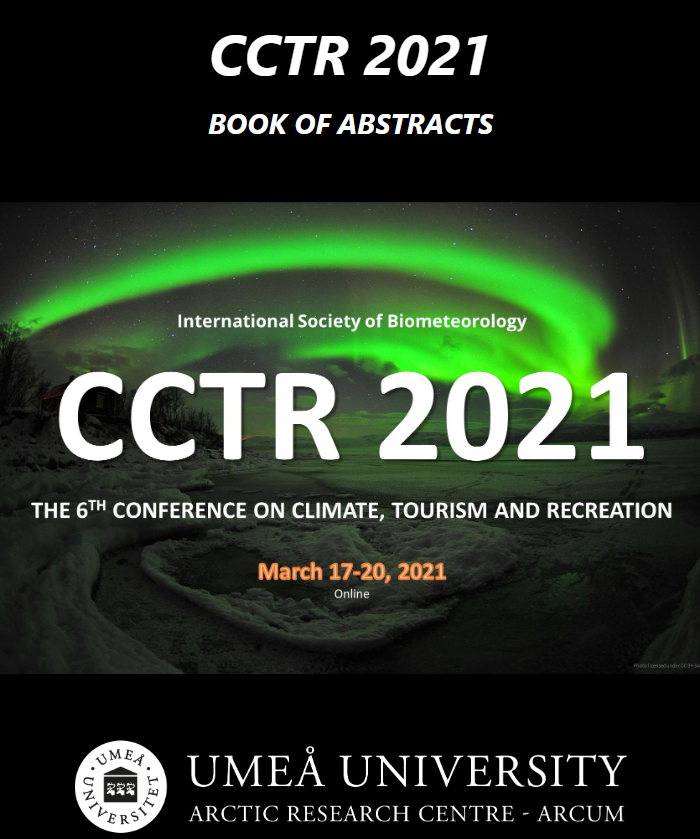
International Society of Biometeorology
Climate, Tourism and Recreation Commission
The ISB Commission on Climate, Tourism and Recreation was initiated during the 14th Congress of the International Society of Biometeorology, held in September 1996 in Ljubljana, Slovenia.
Learn more about the Seventh International Conference on Climate, Tourism, and Recreation (Bø, Norway, March 29-30, 2022)
Past CCTR Proceedings:
- Matzarakis, A. & C. R. de Freitas (Eds.) (2001). Proceedings of the First International Workshop on Climate, Tourism and Recreation. Report of a Workshop Held at Porto Carras, Neos Marmaras, Halkidiki, Greece, 5 -10 October 2001. International Society of Biometeorology.
- Matzarakis, A.; C .R. de Freitas & D. Scott (Eds.) (2004). Advances in Tourism Climatology. Freiburg: Meteorologisches Institut der Universität Freiburg. ISSN: 1435-618X
- Matzarakis, A.; C. R. de Freitas & D. Scott (Eds.) (2007). Developments in Tourism Climatology. Freiburg. ISBN 978-3-00-024110-9
- Demiroglu, O. C.; C. R. de Freitas, D. Scott, M. L. Kurnaz & D. Ünalan (Eds.) (2015). Proceedings of the 4th International Conference on Climate, Tourism and Recreation – CCTR2015. Istanbul: Istanbul Policy Center. ISBN: 978-605-9178-18-1
- Demiroglu, O. C. & D. R. Perkins (Eds.) (2018). The 5th International Conference on Climate, Tourism and Recreation CCTR 2018: Program & Abstracts. June 25-27, Umeå, Sweden.
- Demiroglu, O. C. & B. Rushton (Eds.) (2021). CCTR 2021 Book of Abstracts. March 17-20, Online.
Special Issues
- Scott, D. & S. Gössling (Eds.), Special Issue “Tourism Climatology“, Atmosphere, CCTR 2015
- Steiger, R. (Ed.), Special Issue: Climate, Tourism and Recreation, International Journal of Biometeorology, CCTR 2018
Weather, climate, tourism and recreation
Climate (the concept includes weather) and leisure activities are connected in diverse ways. For example, a period of continuous heavy rain can ruin an otherwise enjoyable holiday, especially if it is unexpected. Other facets of weather can have the same effect on an outing to the local park or football game. “Expectations” of climate are also important. Rainy summers or winters with less than expected snow can affect the numbers of tourists and have significant effects on profits. There is also the misleading concept of climate taken to “a constant”. Holidaymakers and tourist operators often have predetermined expectations about the climate of an area or climate at that locale during a particular time of year or season. Many assume climate conditions to be constant or “normal”. Clearly, tourists and those in the tourism business require appropriate information on climate.
Approaches to recreation and tourism climatology
There has been relatively little research done in recreation and tourism climatology, and much of it appears to be motivated by the potential usefulness of climate information for planning in tourism and recreation. The research often addresses the theme of recreation climate as an adjunct to a variety of decision making processes ranging from those related to such things as the development and location appropriate recreational facilities, or determining the length of the recreation season during which a facility will operate, to those as specific as planning future activities involving personal decisions of when and where to go for a holiday. There is also interest in the indirect effects of climate. For example, Perry (1997) suggests that people leave swimming pools and golf courses on wet days and converge on nearby towns in search of amusement indoors. Therefore, depending on the weather sensitivity of the recreational activity, climatic information can help in the planning, scheduling and promoting of alternative indoor entertainment facilities. Perry (1997) also describes the use of climate information in publicity campaigns to condition tourists’ expectations of climate at certain locations. It is clear that if climatic information is to be useful in decision making, it needs to be presented in a form appropriate to the problem. De Freitas (1990) shows that standard weather data or even secondary climatic variables are not always reliable indicators of the significance of atmospheric conditions. Recreationists respond to the integrated effects of the atmospheric environment rather than to climatic averages.
Weather and climate as a natural resource
Together with geographical location, topography, landscape, flora and fauna, weather and climate constitute the natural resource-base of a place for recreation and tourism.
Weather and climate as limiting factors in tourism
The characteristics of weather and climate are not necessarily determinants of tourism but constitute an important factor in both financial terms for tourism operators and the personal experiences of tourists. Various places in the world have a “tourism potential” and weather and climate set limits. For example, tourism administrators do not promote places with a little potential or appeal as this would not be profitable. On the other hand, the tourist who chooses to visit such places would suffer inconvenience (e.g. transport costs) or discomfort (e.g. heat or cold stress). Financial loses can also result from weather variations and changes. Rainy summers or less snowy winters can have significant impacts on tourism.
Weather and climate as factors in tourism and recreation demand
Weather and climate can affect decisions about holiday destination or the kind of activities engaged in. Weather can play a significant role in the three phases of a trip: before, during and after. Meteorological conditions also affect on-site behaviour of tourists and recreationists.
Weather, climate, health and tourism
Weather and climate can have a variety of effects on the physical wellbeing of holidaymakers (e.g. heat and cold stress, sunburn, effects air pollution and heat stroke). Purpose-designed climate advisory services could help to prepare and protect travelers, especially at-risk groups (the retired, the very young, the sick).
For more information about the limate, Tourism and Recreation Commission, please contact Robert Steiger (robert.steiger[at]uibk.ac.at) who serves as Commission Co-Chair.
Follow @ISB_CCTR on Twitter!
